LED Lighting for Hospital: Benefits and Reasons to Choose
Table of Contents
Did you realize that the type of lighting in a hospital can significantly influence patient health? This underscores the necessity of making thoughtful decisions when selecting lighting solutions for healthcare facilities. In this regard, LED lights emerge as a leading choice. But what makes LED lights the preferred option for hospital environments?
Since hospital lighting operates non-stop, controlling electricity expenses is pivotal. LED lights stand unrivaled in energy efficiency, helping to reduce costs drastically. However, it’s crucial to remember that different areas within the hospital necessitate varying lighting setups. While doctors’ offices require bright, focused lighting, patient rooms benefit from a softer, warmer illumination. Moreover, the availability of cutting-edge options such as UV-C disinfection lights and circadian rhythm lights sets LED technology apart from conventional lighting solutions, marking the commencement of a new era in hospital lighting.
In the following sections, we will delve deeply into the nuances of hospital lighting, elucidating why LED lights are the superior choice for healthcare institutions. Let’s proceed without further ado to explore this critical topic.
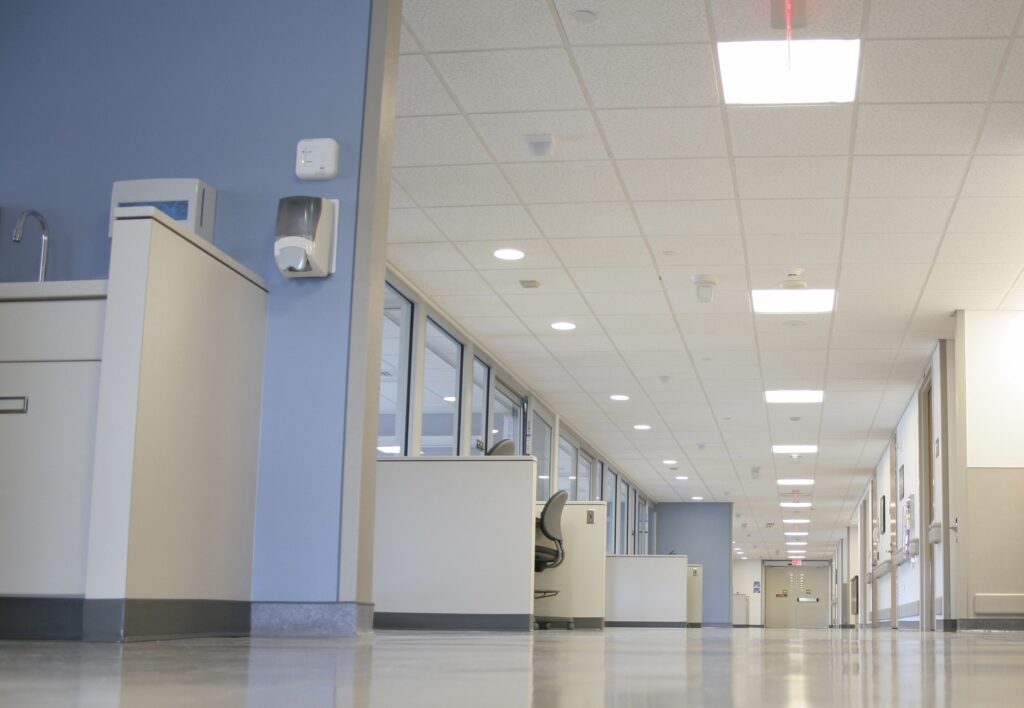
Understanding Hospital Lighting
Hospital lighting encompasses the diverse lighting systems utilized across various healthcare establishments, such as clinics, hospitals, and other medical platforms. It seeks to cultivate an environment where patients feel at ease and healthcare professionals can work optimally, efficiently, and comfortably. It is important to note that the lighting requisites for healthcare settings differ substantially from those of standard commercial spaces. For example, operation theaters often employ mobile lighting solutions to guarantee adaptability and mobility. On the other hand, general areas are best served by LED strips, recessed lights, and panel lights, which are excellent choices for hospitals.
Different sections of a hospital demand distinct lighting specifications concerning brightness, color temperature, and design. Take the reception and lobby areas, for instance – these spaces offer an opportunity to create a welcoming and aesthetically pleasing environment through stylish fixtures. In contrast, areas like doctors’ chambers and patient rooms should prioritize functionality and comfort, with lighting solutions such as LED strips, recessed lights, or flat panel lights fitting the bill perfectly. Stay tuned as we unfold all the vital insights into hospital lighting.
LED Lighting Solutions in Medical Facilities
Hospitals utilize a variety of lighting options to ensure functionality and comfort. Here’s a comprehensive guide to the prevalent choices:
Grid Ceiling LED Panel Lights
These slender and flat lighting fixtures are ideal for hospital grid ceilings, lending a neat and professional atmosphere to various spaces within the facility. They can be installed in corridors, waiting rooms, wards, doctor’s offices, and washrooms, offering uniform and glare-free lighting to reduce eye strain and foster a comfortable setting for patients and medical staff.
Modern Recessed LED Downlights
Consider incorporating commercial recessed lights to bestow a contemporary and stylish appearance to your hospital. These built-in fixtures facilitate a dependable and professional environment, often spotted in corridors, waiting rooms, patient rooms, or expansive and opulent hospital receptions. However, choosing the right type based on your ceiling type is vital to prevent fire risks; refer to our comprehensive guide on IC versus non-IC rated fixtures to make an informed decision.
Compact LED Dome Lights
LED dome lights, perfect for hospitals with space-constrained ceilings, offer solutions for areas requiring broader, diffused lighting, such as nursing stations, hallways, or lounges. These lights are simple to install and upkeep and add a refined touch to the hospital interiors with their understated yet stylish designs.
Ambient LED Strip Lights
LED strip lights are an excellent choice for modernized hospital interiors needing indirect illumination to minimize glare. Commonly found enhancing the ambiance in doctor’s offices, wardrooms, and reception areas, these lights can also be installed underneath cabinets to add a soft and sophisticated touch.
Versatile Mobile LED Lighting
Designed to facilitate adaptable medical examinations and procedures, mobile LED light fixtures are equipped with adjustable components, making them an indispensable tool in various departments, such as gynecology, orthopedics, and urology, among others. These mobile units, including seven and four-reflector theater lights, are primarily utilized in operation theaters, aiding in various surgical procedures.
UV-C LED Sterilization Lights
Hospitals increasingly rely on UV-C LED disinfection lights to maintain a sanitized and germ-free environment, particularly in enclosed spaces such as operation theaters or patient rooms. These potent lights can effectively eliminate bacteria, viruses, and other harmful pathogens, representing a critical asset in the upkeep of high-end hospitals despite their substantial cost.
Emergency Hospital Lighting Systems
Ensuring uninterrupted lighting is crucial, especially during emergencies or power outages. Emergency lighting systems step in during power failures, guaranteeing continuous illumination and safety in vital areas like operation theaters and hallways, thereby preventing potential disruptions in critical medical procedures.
By acquainting yourself with these diverse lighting options, you can optimize the hospital environment to be functional and comfortable, fostering a space conducive to healing and professional medical services.
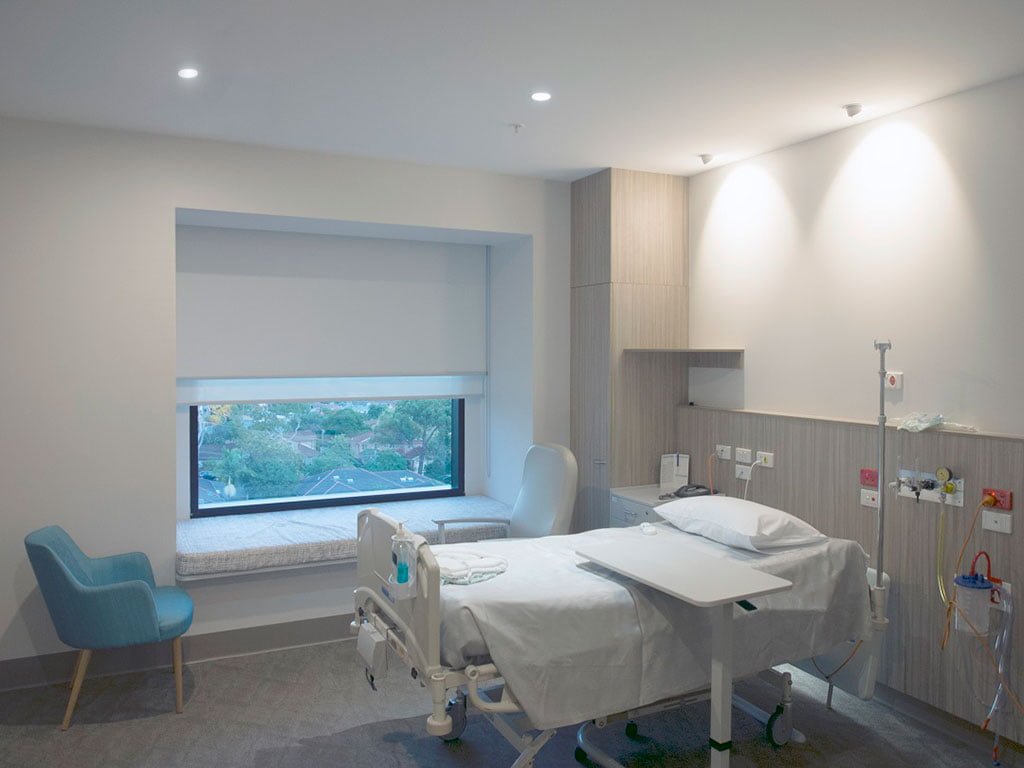
Advantages of Utilizing LED Lighting in Healthcare Facilities
The evolution brought about by LED technology has superseded many traditional forms of lighting, positioning it as an excellent choice for healthcare facilities. Here are compelling reasons to adopt LED lighting in hospitals:
Harmonizing with the Circadian Rhythm
LED lighting significantly influences both mental and physical well-being. These lights can adjust color temperatures, facilitating the regulation of patient healthcare by the staff. Scientifically, lighting intensity and color shifts have been shown to influence hormone levels such as melatonin. Implementing tunable LED lighting in patient rooms can harmonize lighting conditions with the body’s circadian rhythms, enhancing the quality of sleep for patients, an aspect not achievable with conventional lighting options like incandescent or fluorescent bulbs.
Enhancing Patient Care
In healthcare settings, lighting serves a function beyond mere visibility. UV-C LED disinfection lights, for instance, can eliminate germs in hospital rooms, playing a critical role in maintaining sterile environments such as operation theaters. Additionally, adjustable and dimmable features of LED lights contribute to a comfortable patient experience during treatments, thereby augmenting the quality of patient care.
Facilitating Efficient Medical Equipment Tracking
LED lights can be integrated with sensor technologies like RFID and Bluetooth low-energy signals to track medical equipment through tag marks. This efficient tracking system ensures the quick location of medical devices, saving valuable time and enhancing operational efficiency.
Energy Conservation
LED lights are paragons of energy efficiency, significantly surpassing traditional lighting options. They provide the same luminosity as a 60-watt incandescent bulb while consuming only 6 watts of energy, making them an ideal choice for hospitals that operate round the clock and effectively reduce electricity expenses. Further insights can be acquired from the article “Advantages and Disadvantages of LED Lighting.”
Boosting the Productivity of Medical Staff
LED lighting offers a uniform illumination that prevents direct glare, ensuring a conducive working environment for the medical staff. It allows for light intensity and brightness adjustments per the requirements, facilitating tasks like detailed examinations by improving visual contrast and minimizing eye strain, thereby enhancing staff efficiency.
Economic Benefits
Though the initial investment might be higher, LED fixtures present a cost-effective solution in the long run. They do not necessitate frequent replacements or repairs like their traditional counterparts, translating to substantial cost savings over time.
Extended Durability
LED lights boast an impressive lifespan, glowing for up to 50,000 to 100,000 hours if maintained adequately, far surpassing the longevity of incandescent and fluorescent lights. This extended lifespan and reduced maintenance needs make LEDs a wise investment for long-term lighting solutions. For a detailed comparison of various lighting options and their lifespan, refer to the comparison table included below.
Healthcare facilities can significantly enhance operational efficiency and patient care by adopting LED lighting solutions and realizing substantial economic and energy savings.
| Lamp type | Lumens/Watt | Avg. Lumens/Watt | CRI | Lifespan (Hrs) |
| Incandescent | 8-18 | 14 | 100 | 1000 |
| T12 Fluorescent | 40-70 | 55 | 92 | 8000 |
| T8 Fluorescent | 60-80 | 70 | 85 | 6000 |
| T5 Fluorescent | 100-105 | 102.5 | 85 | 9000 |
| Mercury | 44-57 | 50 | 50 | 24000 |
| LED | 75-200 | 137.5 | 98 | 50000+ |
Reduced Thermal Output
Unlike conventional lighting solutions, LED systems are engineered to prevent excessive heat buildup, benefiting from an advanced heat dissipation mechanism that maintains a cooler bulb temperature. (Explore this aspect further here – LED Heat Sink: Understanding Its Role and Significance.) By averting the potential overheating commonly associated with traditional light fixtures, they significantly mitigate the risk of fire hazards. This characteristic renders them exceptionally suited for hospital installations, specifically in areas where temperature-sensitive instruments or medications are stored.
Eco-Conscious Choice
Compared to traditional lighting alternatives, LEDs are devoid of harmful gas emissions and maintain a noticeably smaller carbon footprint. Their longevity not only diminishes manufacturing demands but contributes substantially towards reducing global warming repercussions. Therefore, they act as stewards in preserving the environment.
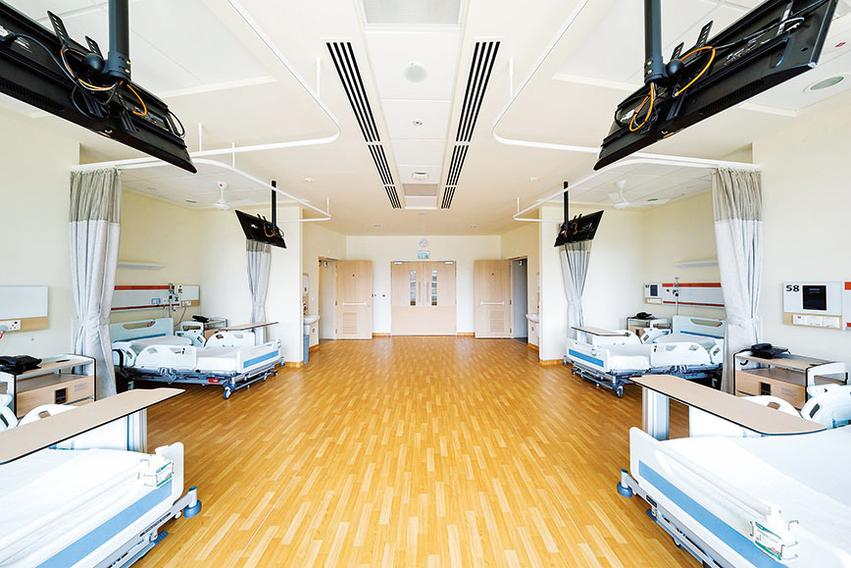
Hospital Lighting Sectors
We have sectioned the hospital into various sectors to optimize illumination. Please approach the following zones with tailored lighting solutions that address unique needs:
1. Universal Background Lighting
Universal background lighting is central to maintaining a bright and welcoming hospital environment. This encompasses the main lobby, hallways, and additional communal spaces. While LED panels or dome lights are the typical choices, considering recessed lighting or LED strips might add a fresh touch.
2. Welcome Desk Illumination
The welcome desk is the initial point of contact for visitors arranging appointments. Since most hospitals boast elegantly designed receptions, complementing it with LED strip lights can enhance its aesthetic appeal. Additionally, incorporating modest pendants or hanging fixtures can create a serene ambiance. To spotlight the hospital’s name or logo attractively in the background, utilize LED neon flex but moderate brightness to maintain a professional atmosphere.
3. Physician’s Office Lighting
Regarding the physician’s office lighting, utmost attention is required to foster a setting where patients can be examined and diagnosed effectively. Here, task lighting that ensures clear visibility is essential. While LED downlights are recommended for examination areas, panel lights or LED strips can create a soothing ambient illumination.
4. Surgical Suite Lighting
Bright and focused lighting in the surgical suite is critical to facilitating precise operations. The lighting here should offer enough lumens to delineate anatomical aspects without inducing eye strain for the surgeon, considering they spend extended periods in this area.
5. Diagnostic Room Illumination
Different diagnostic rooms, such as those for X-rays, blood tests, or EEGs, demand varying lighting specifications. Collaborate with a lighting expert with medical understanding to formulate the optimal lighting solutions for these rooms.
6. Patient Room Lighting
For patient rooms, choose adaptable lighting fixtures that allow individuals to modify the ambiance to their preference. Endeavor to maximize natural light during the daytime to foster a healing environment.
7. Hallway Illumination
Hallway lighting should facilitate ease of movement, focusing on evenly spaced lighting fixtures to prevent shadowy areas and ensure safety and comfort.
8. Lounge Area Lighting
In the lounge areas where patients and visitors might spend extended periods, installing warm, subdued lighting can enhance comfort and reduce the strain of waiting.
9. Restroom Lighting
For restrooms, prioritize hygiene, safety, and clarity. Motion-activated lights can be a sustainable choice, activating only when the space is occupied, thereby saving energy.
10. Pharmacy Lighting
In the bustling pharmacy area, precise, excellent lighting is vital to aid staff in reading prescriptions and identifying the correct medications without difficulty.
11. Exterior Lighting
The exterior lighting plan should encapsulate signboards, parking spaces, and walkways, balancing visibility and non-intrusiveness for passersby.
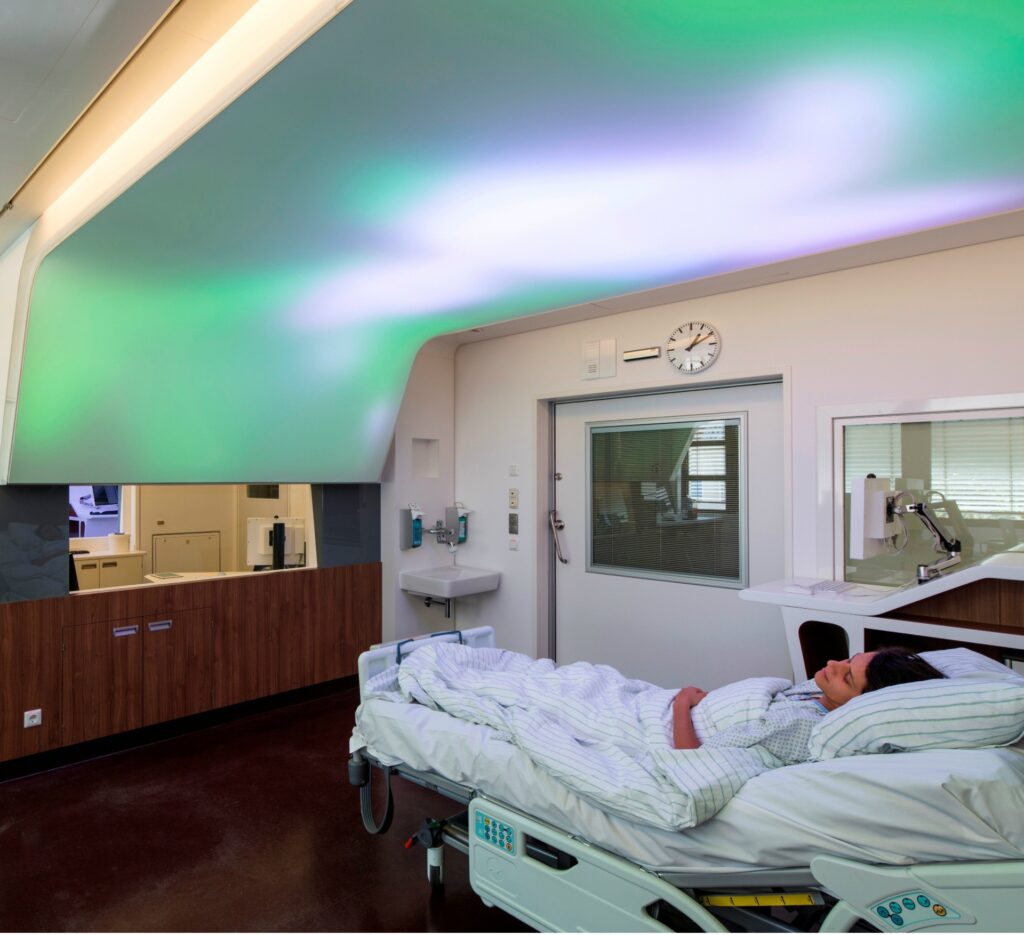
Legal Considerations and Regulatory Guidelines for Hospital Illumination
Several global entities have established guidelines concerning illumination within hospital environments. These guidelines are crafted for the well-being and comfort of patients and healthcare staff. The most notable legal directives are listed below:
The Illuminating Engineering Society (IES) has proposed recommendations to ensure safety in hospital lighting. The recommendations include:
| IES Hospital Lighting Standards | ||
| Industry | Area | Foot Candles |
Hospitals |
Lobby Area | 50 lx (5 FC) |
| Waiting Room (General) | 100 lx (10 FC) | |
| Patient Ward Room (Observation) | 300 lx (30 FC) | |
| Medical Laboratory | 500 lx (50 FC) | |
| Operating Room (Table) | 3000 – 10000 lx (300 – 1000 FC) | |
| Critical Care Areas (Examination) | 500 lx (50 FC) | |
| Corridors | 50 – 300 lx (5-30 FC) | |
| Emergency Rooms | 500 – 1000 lx (50-100 FC) | |
| Operating Rooms | 1000 – 2000 lx (100-200 FC) | |
The ANSI/IES RP-29-16 has undergone revisions to its hospital lighting standards. The newly amended directives suggest two distinct levels of lighting: one for daytime and another for nighttime. To illustrate, the hospital’s lobby should maintain a lighting intensity of 800 lux during daytime and 400 lux during nighttime hours, fostering a visually comfortable environment.
Factors to Keep in Mind for Hospital Illumination
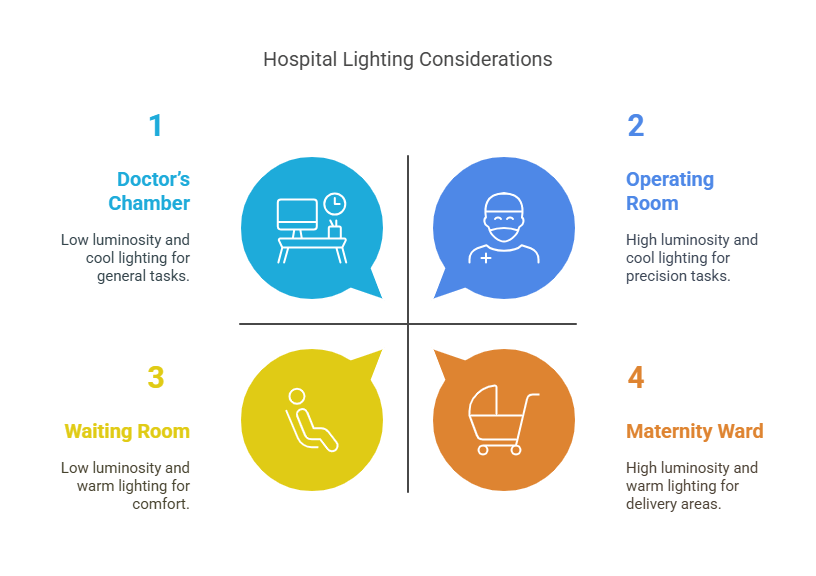
The illumination needs of hospitals vary significantly from other business spaces. Therefore, before selecting any lighting solutions for a healthcare facility, please take into account the following aspects:
Luminosity
Maintaining the optimal level of luminosity in a hospital setting is vital. Overly bright lights can result in eye fatigue, creating a discomforting environment for patients and staff. Conversely, inadequate lighting can impede medical professionals from conducting examinations and procedures effectively. Hence, selecting fixtures with the appropriate brightness level is of utmost importance. To assist you in this endeavor, here is a chart that outlines suggested lux ratings for various areas within a hospital, facilitating proper illumination throughout the facility:
| Hospital areas | Type Of Work | Recommended Lux Level (minimum) |
| Doctor’s Chamber | General Lighting | 150 lx |
| Working Table | 500 – 1000 lx | |
| Operating Room | General Lighting | 500 -1000 lx |
| Working Table | 20000 – 40000 lx | |
| X-Ray Ward | 0 – 50 lx or 0 -100 lx | |
| Maternity Ward | Delivery Bed | 5000 – 10000 lx |
| Delivery Area | 500 – 250 lx | |
| Infant and Waiting Area | 100 – 200 lx | |
| Patients Room | General Lighting | 150 lx |
| Localized Bed lighting | 250 – 500 lx | |
| Dentistry | General | 250 – 500 lx |
| Chair | 5000 – 10000 lx | |
| First Aid Ward | Localized | 500 – 1000 lx |
| General | 10000 – 20000 lx | |
| Laboratory | Research Area | 250 – 500 lx |
| Working Table | 500 – 1000 lx | |
| Waiting Room | 150 lx | |
| Corridors and Staircases | 150 lx | |
| Library | 250 – 500 lx | |
| Bathroom | General | 100 – 200 lx |
| Mirror | 200 – 400 lx | |
| Hospital kitchen | 250 – 500 lx |
Lighting Hue Spectrum
The hue spectrum of lighting is defined by its color temperature. A higher color temperature produces a cooler, bluish illumination, while a lower value creates a warm, yellowish glow. This variation in lighting has significantly influenced the atmosphere within hospitals. Areas necessitating focused activity, such as doctors’ desks and operating rooms, benefit from excellent lighting. On the other hand, warm lighting emerges as the ideal choice in spaces where a homely and soothing ambiance is desirable – a perfect fit for waiting rooms and receptions, for instance.
Conversely, certain areas are adaptable to warm or cool lighting, including stairways, corridors, parking garages, and building facades. The choice of color temperature here is essentially subjective and leans on individual preferences. Notably, most hospitals utilize neutral or natural daylight tones for general illumination.
Spectrum Divisions for Color Temperature
- Warm Lighting: 2000K to 3000K
- Excellent Lighting: 4000K to 5000K
- Neutral/Daylight: 5000K to 6500K
This guide aims to assist you in choosing appropriate color temperatures for various areas within a hospital. As you navigate the complexities of Warm Light versus Cool Light: Uncovering the Ideal Choice and Its Rationale, remember, if you find yourself undecided regarding the optimal color temperature for your hospital, consult the subsequent chart for expert suggestions.
| Different sections of Hospitals | Recommended Color Temperature | Light Tone |
| Doctor’s Office | 4000K-5000K | Cool Lighting |
| Reception | 3000K-4000K | Warm lighting |
| Waiting Room | 3000K-4000K | Warm lighting |
| Patients Ward | 3000K-4000K | Warm lighting |
| Operation Theatre | 5000K-6500K | Neutral/Daylight |
| Examination Room | 4000K-5000K | Cool lighting |
| Hospital Bathroom | 4000K-5000K | Cool lighting |
| Corridor and Staircase | 3000K-4000K | Warm lighting |
| Hospital Garage/Parking lot | 4000K-5000K | Cool lighting |
Optimizing Energy Use
Keeping hospital lights operational round the clock leads to inflated electricity bills. To mitigate these costs, considering energy-efficient alternatives is prudent. In this regard, LED lights emerge as the superior choice, offering significant energy savings without compromising illumination quality. Compared to traditional incandescent lights, LEDs are known to utilize up to 85% less energy, making them the preferred choice for hospital lighting solutions.
Enhanced Commercial Lighting Standards
In commercial setups like hospitals, lighting demands vary significantly from residential settings. Various areas within the hospital premises, such as laboratories, are subjected to chemical vapors, hazardous substances, and moisture. These spaces might also be prone to explosion risks. Therefore, implementing resilient light fixtures that can withstand these challenges is vital. Commercial-grade lighting systems are indispensable in such environments. This resource will provide insights into ideal specifications, including IP, IK, and CRI ratings, fixture selection based on varied ceiling heights, and other crucial considerations.
Incorporating Motion Sensors and Timers
LED lights with motion sensors and timers can exponentially decrease energy usage. Strategically place these fixtures in sporadically occupied spaces such as restrooms, storerooms, or staff lounges. Implementing motion sensor technology ensures lights are activated only when the space is in use, minimizing wastage. Additionally, timers can regulate patients’ circadian rhythms, controlling light exposure during rest periods.

Strategies for Enhancing Hospital Lighting
You gathered insights on selecting the optimum hospital lighting solutions in the preceding segment. Now, I am going to share some strategies and techniques to foster a proficient hospital lighting atmosphere:
Transition to LED Lighting
Numerous hospitals and healthcare establishments still depend on fluorescent lighting, which, although known for its intense and sustained illumination, carries significant disadvantages. While they may be more energy-efficient and have a longer lifespan than conventional incandescent bulbs, the negative aspects cannot be ignored. These lights produce various forms of radiation and release neurotoxic mercury, potentially impairing mental and physical health over time. These issues can be mitigated by adopting LED lighting, which promises a longer lifespan and avoids the utilization of harmful substances, promoting healthier patient experiences.
Employ LED Panel Lights for Adaptability and Ease
LED panel lights stand out with their broad beam angle, proficiently lighting up expansive areas. Their sleek design harmonizes perfectly with the hospital environment, making them an aesthetically pleasing choice. Available in various wattages and brightness levels, these fixtures can be implemented throughout the hospital premises, from consultation rooms to patient wards. These lights ensure uniform illumination, avoid creating hot spots, and are energy-efficient and durable, serving as an excellent choice for healthcare settings.
Implement Human-Centric Illumination
Human-centric lighting aligns with the body’s natural circadian rhythms, offering adjustable settings suitable for different times of the day. For example, the intensity can be reduced during the day, or the color temperature can be shifted to a warmer hue during the evening, facilitating a nurturing environment for patient care and recovery.
Introduce Smart Bulbs for Increased Efficiency
Incorporating smart bulbs can considerably enhance the operational efficiency of a hospital. These bulbs have dimming, color temperature modulation, and motion detection features. Furthermore, specific models can even trace equipment, helping to locate medical apparatus swiftly in case of misplacement or theft. Utilizing these innovative lights can augment the quality of patient services while optimizing hospital management.
Establish Emergency Lighting Systems
Ensuring an uninterrupted power supply is vital in critical public service areas like hospitals, where a sudden blackout can potentially endanger lives. To prevent catastrophes, such as a power outage during critical surgeries, it’s imperative to install emergency backup lighting systems. These systems activate instantaneously during power cuts, safeguarding against life-threatening situations and maintaining a safe and secure environment within the hospital premises.
10 Innovative Approaches to Hospital Illumination
Explore these innovative approaches to elevate your hospital lighting:
Enhancing Visibility with Outdoor Hospital Lighting: Spotlight the Signboard
Hospitals are often situated in bustling areas, necessitating visible and vibrant signage to guide individuals easily, even from a distance. Lighting up the signboard becomes a crucial aspect of achieving this. While most hospitals highlight their name or logo at the front, consider installing them atop the building, ensuring a clear sightline for passersby. Utilize LED neon flex lights for their flexibility in shaping letters or crafting logos, standing as an optimal choice for this purpose.
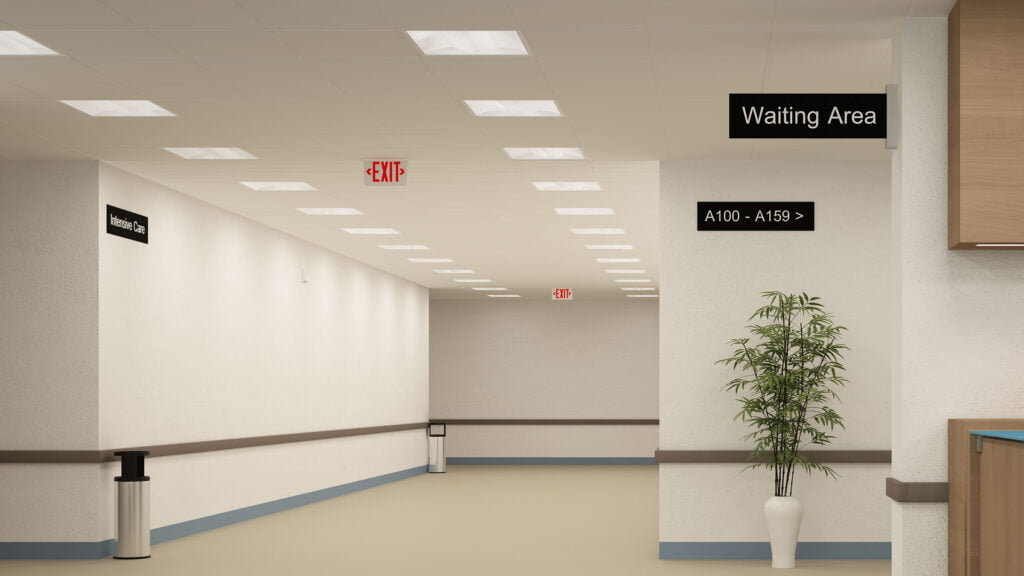
Reception Area Enhancement with LED Strip Lights
Transform your reception area into a welcoming space that reflects quality and comfort. Incorporate LED strip lights in cove lighting styles on the ceiling to accentuate the elegance of the surroundings. These lights complement wooden interiors impeccably, offering many customization options due to their flexibility and size. Feel free to experiment with different layouts to add a unique dimension to the reception space.
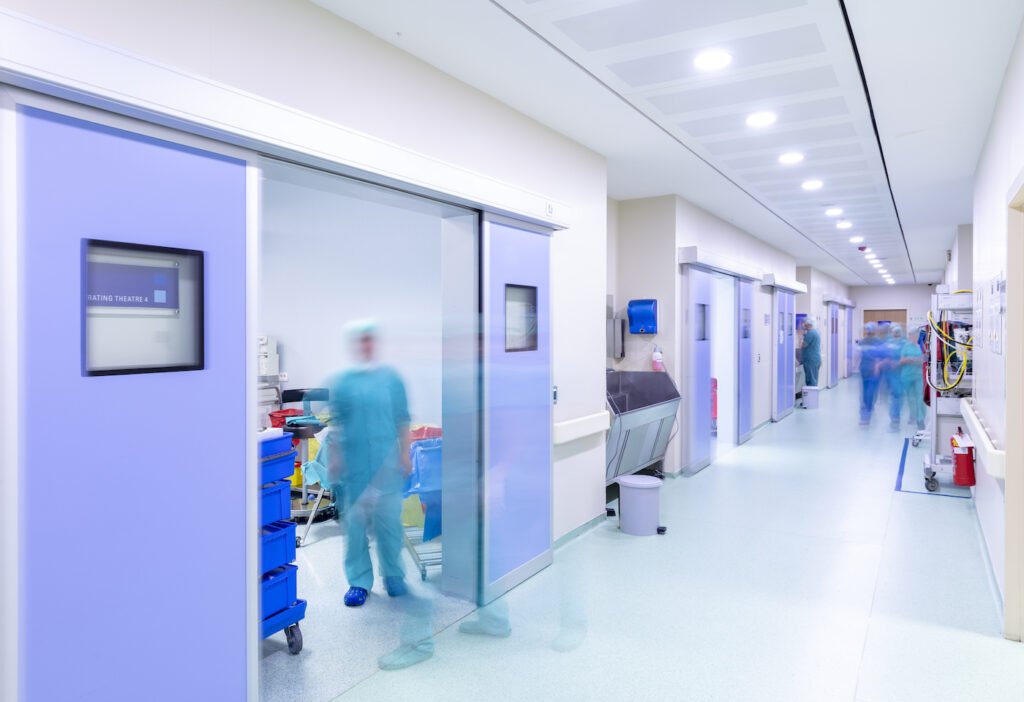
Harnessing the Power of Natural Light
Prioritize the infusion of natural light to foster a rejuvenating atmosphere within the hospital premises. Make the most of daylight by introducing features like glass walls, which can generously illuminate corridors and walkways during the day. Additionally, consider installing elongated window glasses to channel sunlight into patient wards, promoting well-being while minimizing electrical consumption.
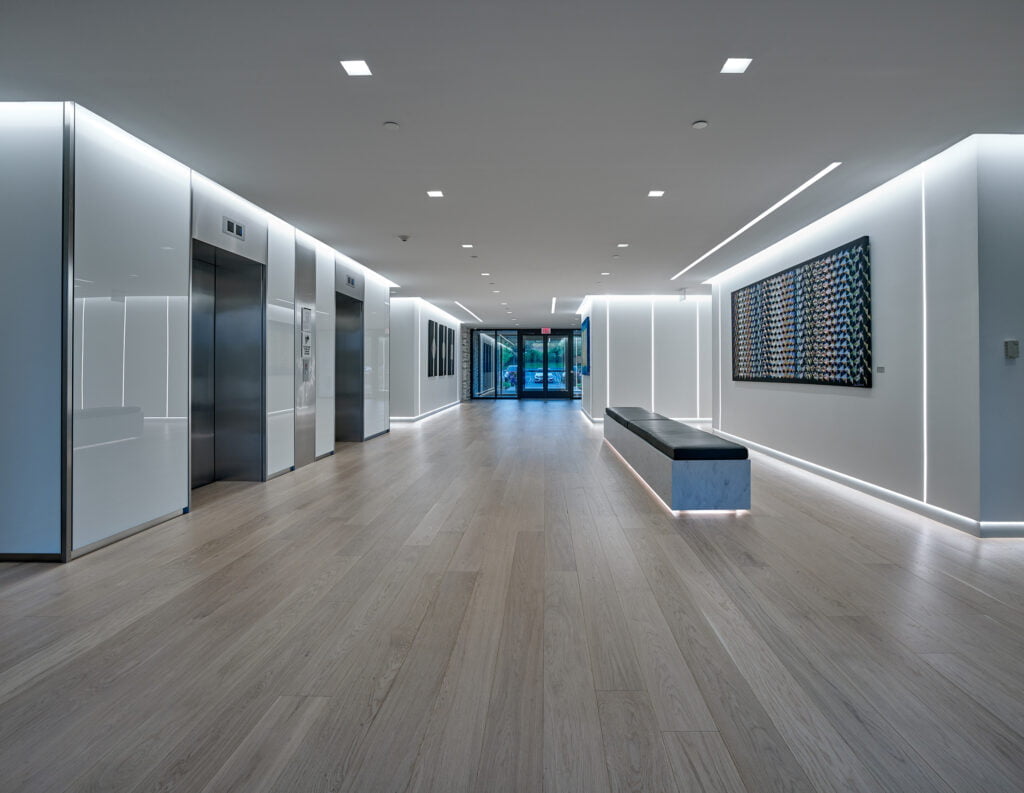
Personalized Lighting Solutions in Patient Rooms with Tunable Lights
Equip VIP patient rooms with tunable lighting fixtures to offer a customizable lighting experience. These installations empower patients to adjust the room’s color temperature based on their preferences and activities, fostering a pleasant and comfortable environment. For instance, a warmer light setting can foster relaxation and facilitate restful sleep.
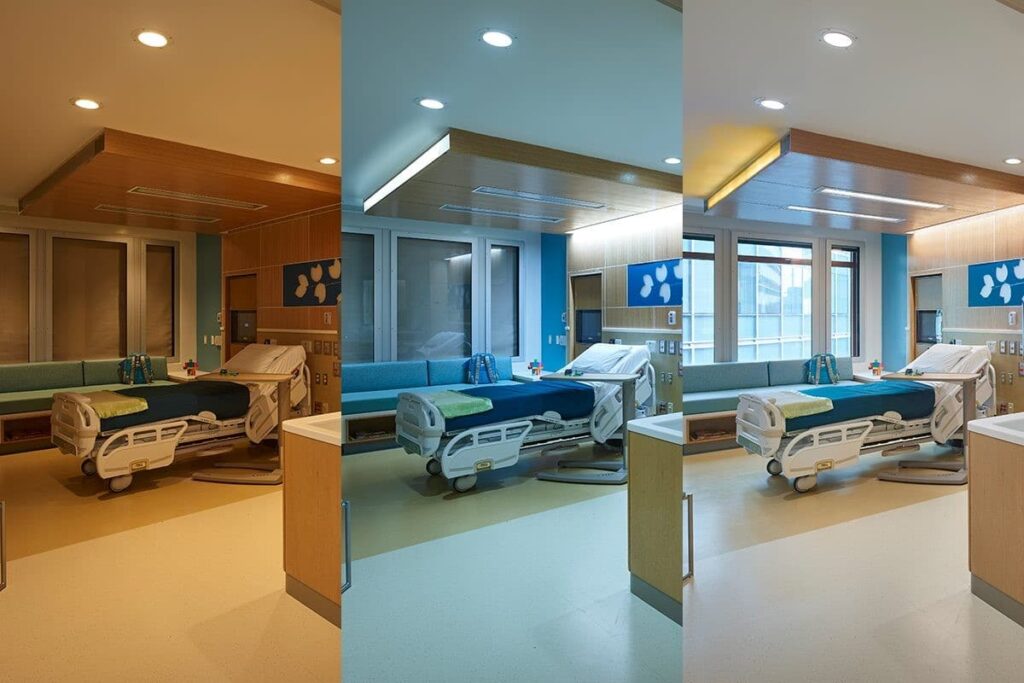
Adaptable Illumination in Doctors’ Chambers with Dimmable Lights
Segment the doctor’s chamber into two functional areas: consultation and examination. The consultation zone, where discussions and prescriptions occur, requires subdued lighting to maintain a calming atmosphere. Conversely, the examination area demands brighter lighting to facilitate precise assessments and check-ups. Implementing dimmable light fixtures can be a remarkable choice here, allowing doctors to modulate the lighting intensity per task, enhancing comfort and efficiency in the process.
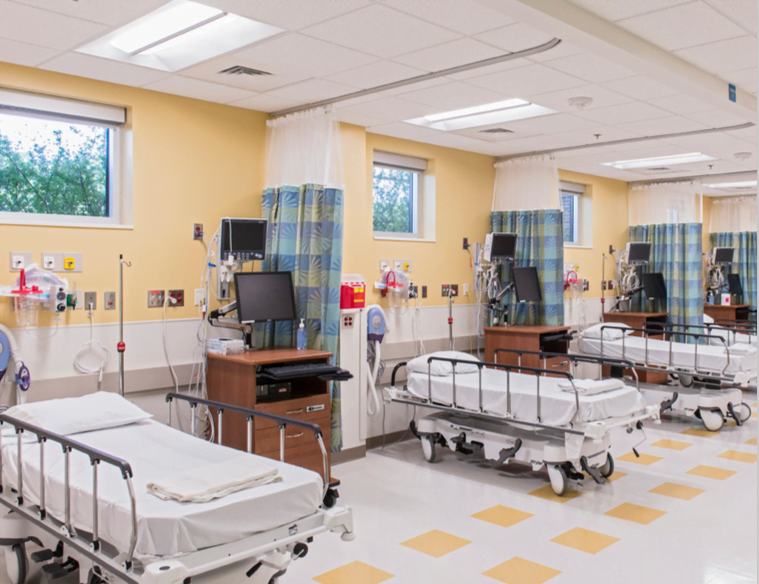
Incorporate a Geometric Light Piece in the Waiting Area
Patients may sometimes wait for a substantial period before their doctor’s appointment. It’s imperative to offer them a serene and inviting atmosphere during this wait. Consider incorporating light fixtures with geometric shapes to introduce a striking focal point to the space. It’s advisable to opt for understated designs to maintain the professional and tranquil character of a hospital setting. Simple yet stylish round or oval fixtures would suffice, ideally suspended from the ceiling to maximize their impact.
Elevate Spaces with Tasteful Designer Illumination
To break away from the monotony of traditional hospital lighting, consider integrating tasteful designer lights that add a dash of modernity without being too overpowering. Pendant or hanging lights, characterized by their simplicity, could be a suitable choice. Position them strategically in areas like the reception, corridors, or waiting room to augment the aesthetic appeal while subtly enhancing your hospital’s brand image.
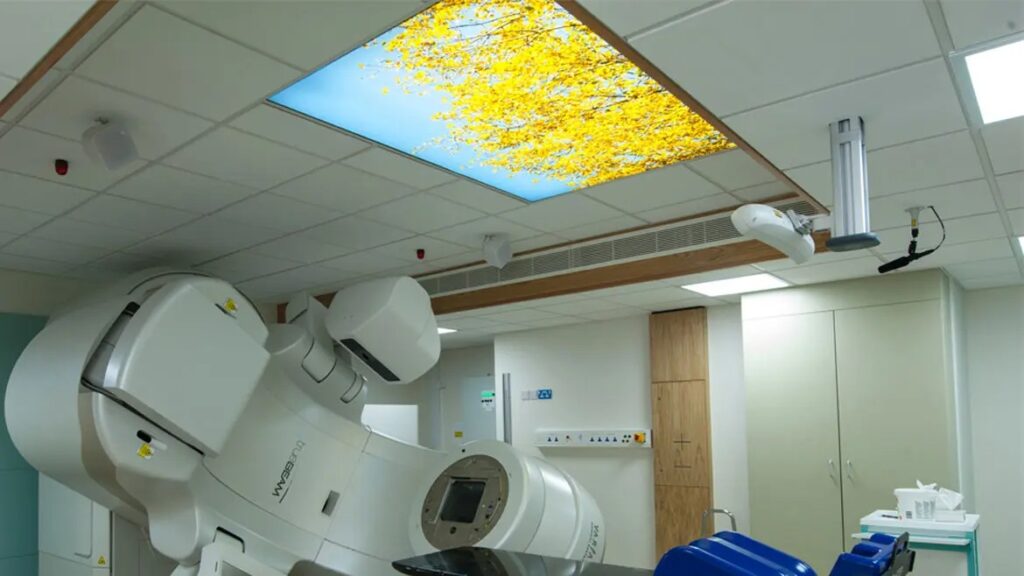
Revamping the Hospital Lobby with Diverse Lighting Options
The hospital lobby is a canvas for exploring various lighting solutions to create a welcoming and aesthetically pleasing environment. Experiment with a mixture of recessed lights, LED strips, lanterns, and pendant lights to find the ideal balance. Long pendant lights in the lobby’s center can impart an elegant touch. Always ensure that the chosen fixtures align well with the overall interior design theme of the hospital.
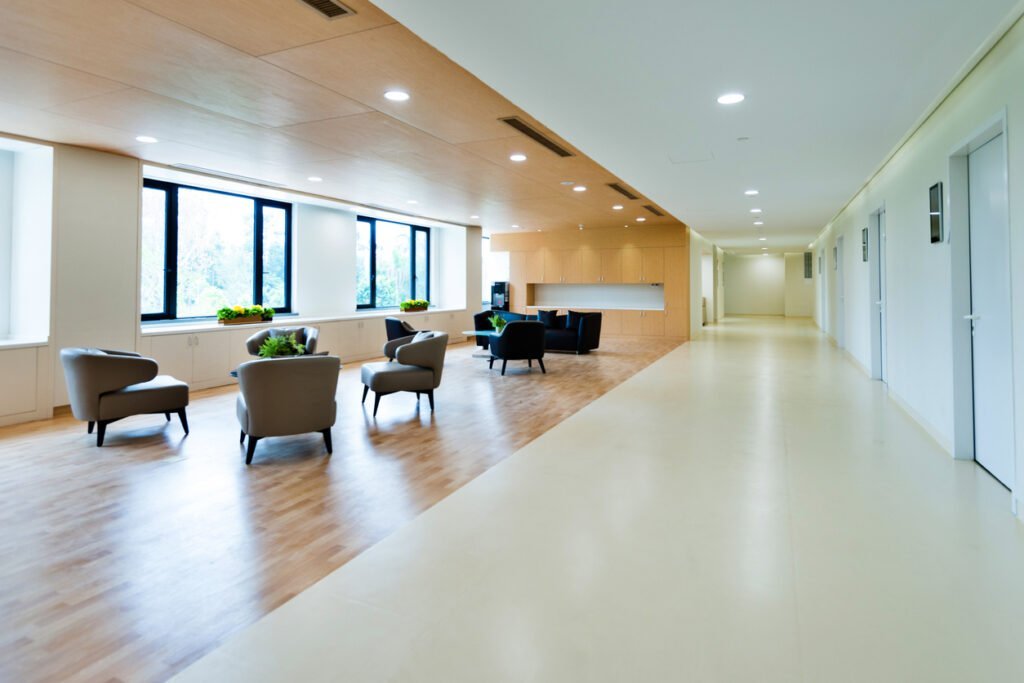
Implement Motion-Sensor Lights in Hospital Restrooms
Divide the restrooms in commercial setups like hospitals into two distinct sections: a. the vanity area equipped with mirrors and basins for freshening up, and b. the lavatory area. Utilize motion-sensor LED strips around the mirrors, which activate instantly when someone approaches to freshen up. This not only conserves energy but also enhances the user experience. For general illumination, LED panels or recessed lights are effective choices, with motion-sensor lights proving efficient for lavatory areas, helping to save electricity that would otherwise be wasted with lights left on continuously.
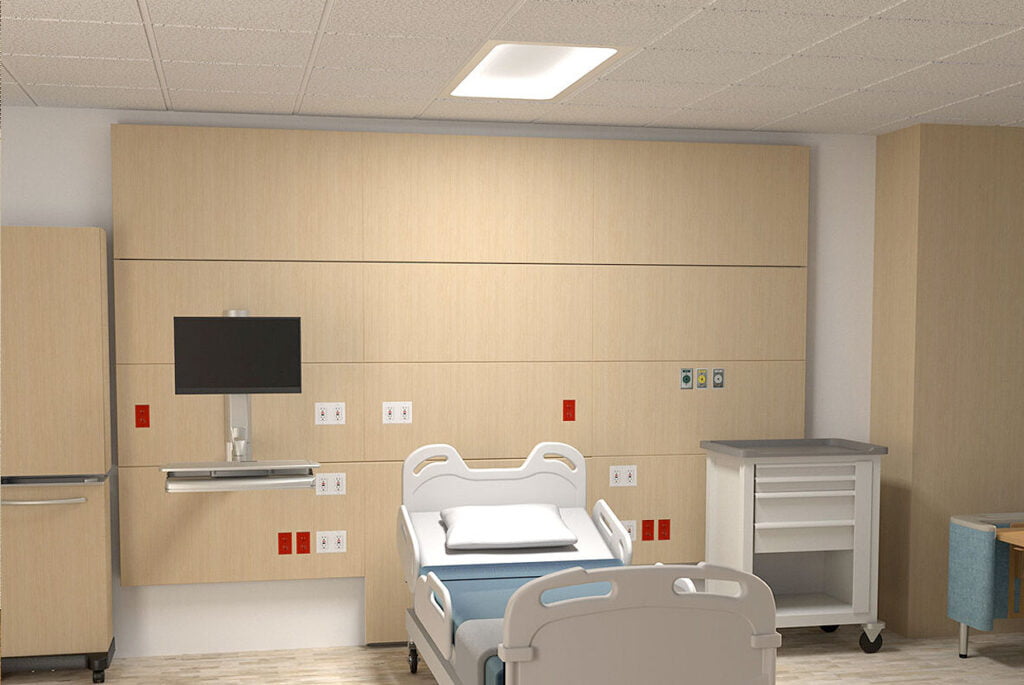
Enhancing Pharmacy Visibility with Suspended Task Lighting
Recognizing the pharmacy as a pivotal and bustling section of the hospital, optimal lighting is vital. Introduce hanging lights to facilitate better visibility, particularly over areas like the cash counter or customer service desk. While choosing the light fixtures, maintain a restrained and harmonious design that complements the pharmacy’s interiors and the hospital’s overall ambiance. Additionally, incorporating spotlights or LED strips to illuminate medicine cabinets can be functional and aesthetically pleasing.
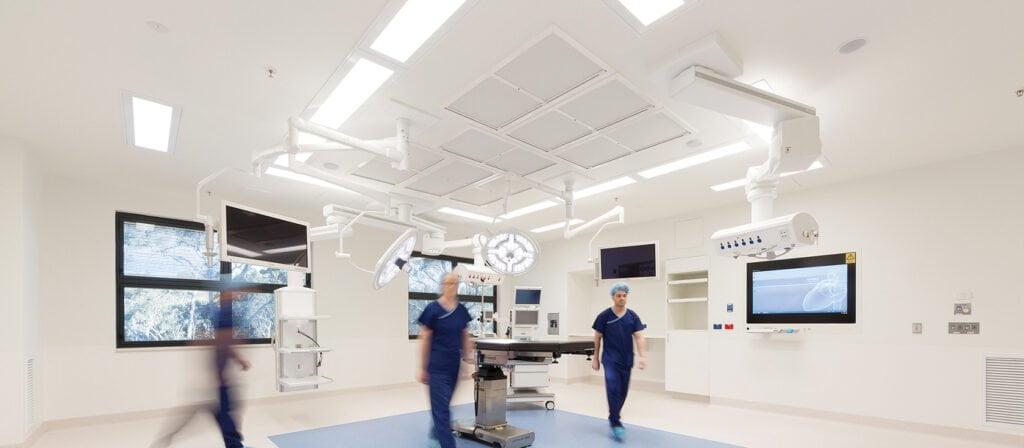
Conclusion
Opt for LED lighting systems for the foremost solution in interior and exterior illumination within hospital environments. Select streamlined, subtle fixtures like LED panels, strips, and inbuilt lights. Essential considerations in your selection process should encompass brightness, color temperature, and control functionalities.
LED strips, renowned for their soft, indirect illumination, are exceptionally suited for hospital settings. Their versatility is evident in their adaptability to various spaces, including reception areas, corridors, medical practitioners’ offices, patient rooms, and beyond. Notably, LED strips with adjustable color temperatures are a prime choice in patient rooms, offering the unique advantage of customizable color temperatures. Moreover, monochrome LED strips can introduce a contemporary flair to hospital lobbies, stairwells, or entrances.
For distinctive exterior illumination, ponder on incorporating LED neon flex lights. These adaptable lighting fixtures can be shaped to replicate your hospital’s name or emblem, guaranteeing prominent visibility even from afar and facilitating easy identification and location of the hospital by visitors.
Seize the moment and connect with MyLikeLed for premium-quality LED strip lights and neon flex solutions. We are at your service, offering ODM, OEM, and customization options, empowering you to acquire bespoke lighting setups for your hospital. Compromise not on your lighting choices – make MyLikeLed your preferred choice.
FAQs
LED lighting offers several key benefits for hospitals. It provides brighter and more controlled lighting, helping medical staff maintain a calm and safe environment. LEDs are also energy-efficient, long-lasting, and generate less heat, reducing the need for frequent replacements or maintenance. Additionally, many LED systems support IoT integration, allowing for advanced control and automation that traditional lighting systems cannot offer.
LED lighting improves patient outcomes by creating a more comfortable and healing environment. Features like tunable white lighting allow staff to adjust the color temperature to align with patients’ natural circadian rhythms. This helps patients relax, sleep better, and recover faster—contributing to overall improved health outcomes.
LED lighting can significantly reduce energy costs in hospitals. LEDs use up to 85% less energy than traditional lighting. When combined with features like motion sensors and timers, hospitals can optimize usage and further cut down on electricity bills. Plus, the longer lifespan of LEDs means lower maintenance and replacement costs over time.
Yes, LED lights are very safe and comfortable for hospital settings. They produce consistent, flicker-free lighting that reduces eye strain for both patients and staff. Since LEDs emit less heat, they also help keep rooms cooler, which is especially important in temperature-sensitive medical areas.
Absolutely. Many modern LED lighting systems are designed with IoT and automation compatibility. This means they can be connected to hospital management systems for automated scheduling, motion-activated lighting, and even remote control. This improves efficiency, saves energy, and allows staff to focus more on patient care.

Hi, I’m Xylia Xiong, a sales professional with 14 years of experience in the LED strip light industry. I specialize in providing tailored solutions, leveraging my expertise in LED products and the latest industry trends. Known for effective communication and problem-solving, I’m dedicated to helping lighting manufacturers, importers, and distributors achieve their goals.
Let’s work together to create customized solutions that exceed expectations.
Related Posts

The Best LED Strip Lights You Can Buy Right Now

Comparing WS2811 Vs WS2812B: Key Differences


